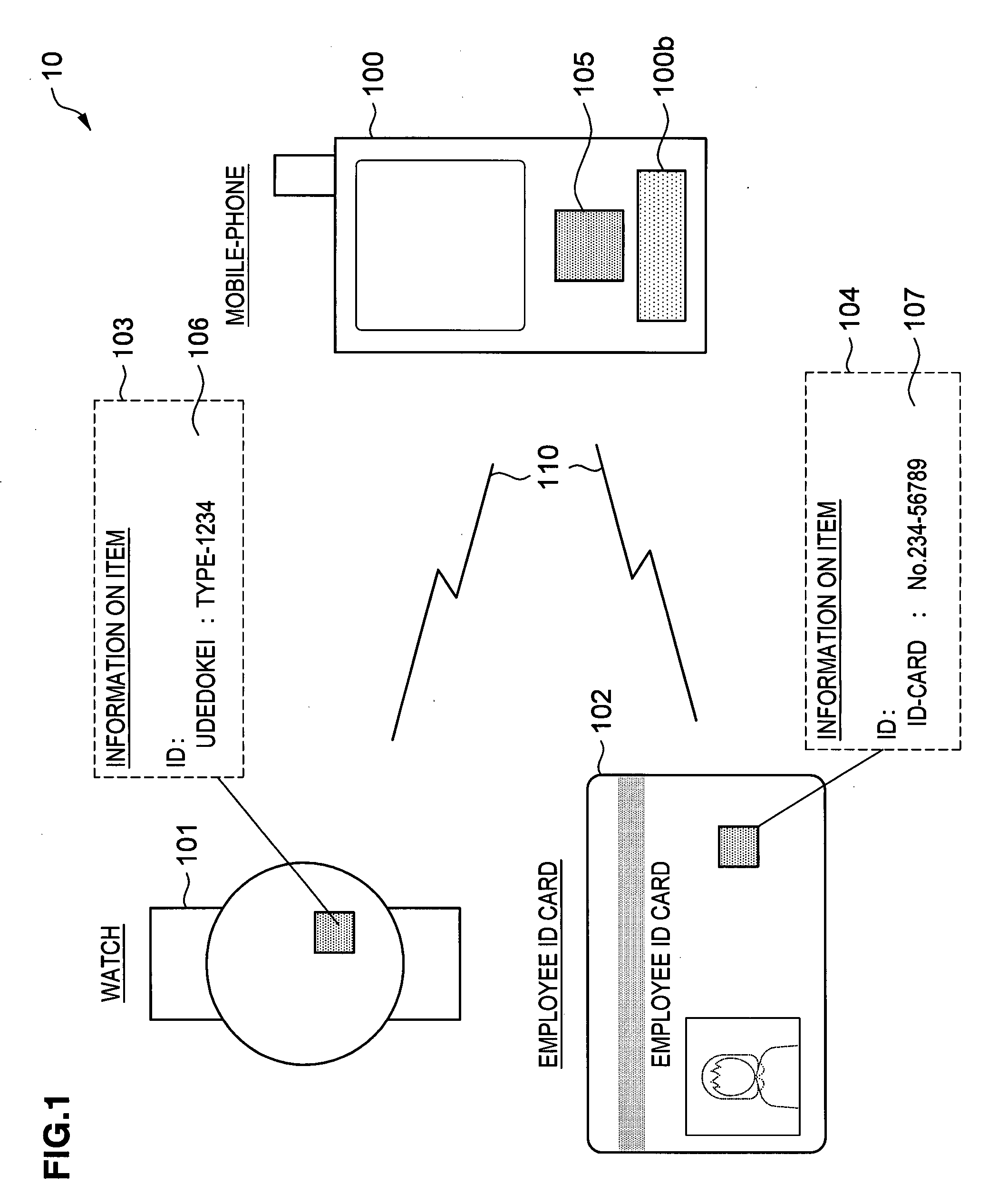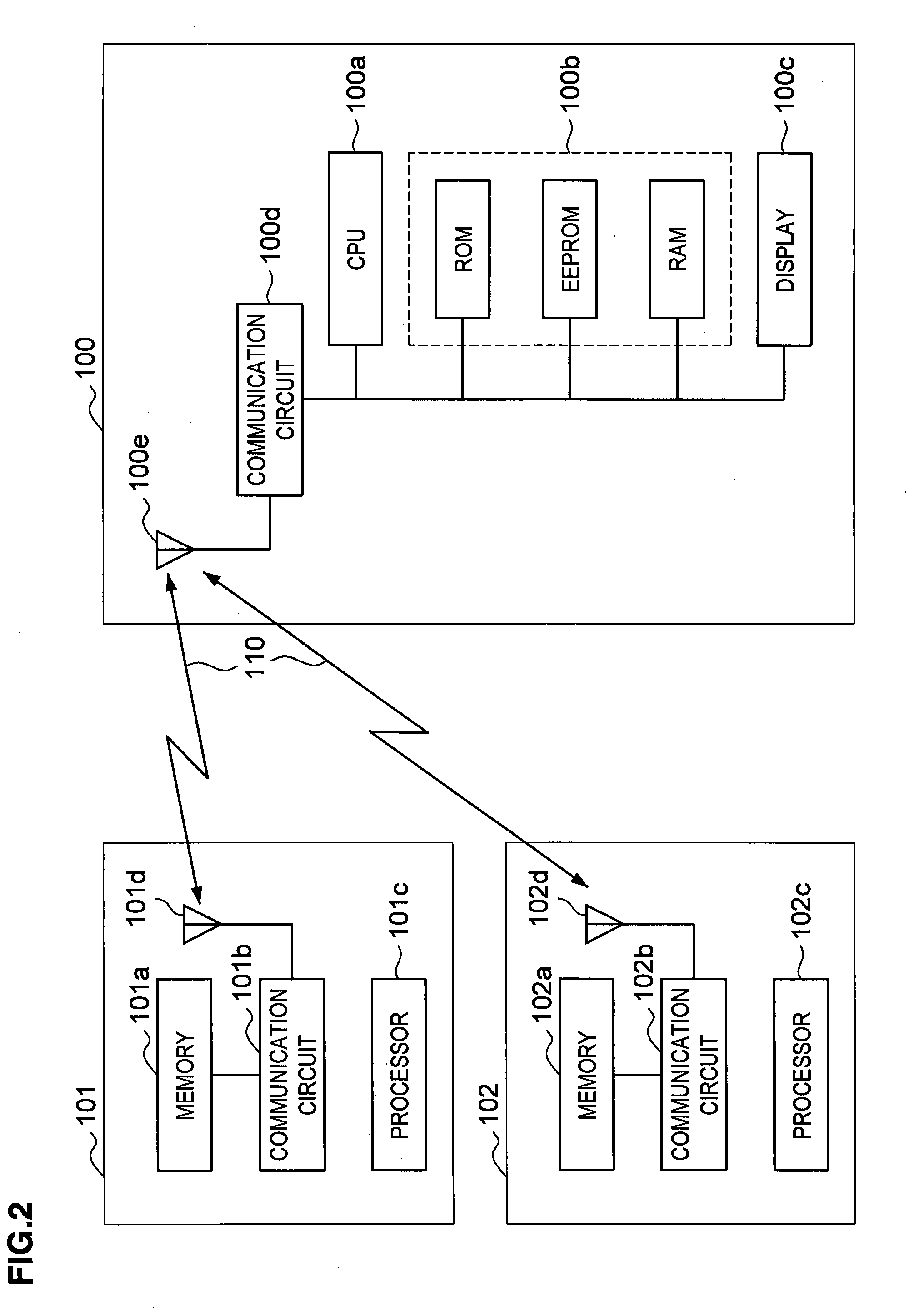Portable electronic device, security system and method for determining allowable operating range of portable electronic device
- Summary
- Abstract
- Description
- Claims
- Application Information
AI Technical Summary
Benefits of technology
Problems solved by technology
Method used
Image
Examples
first embodiment
[0070]First, a whole configuration of a security system according to the first embodiment of the present invention will be described in reference to FIG. 1. A security system 10 according to this embodiment is configured by a mobile-phone 100 as an example of mobile terminal and items 101, 102. The mobile-phone 100 is connected to the items 101, 102 by a radio interface 110.
[0071] Mobile-Phone
[0072]As shown in FIG. 2, the mobile-phone 100 is configured by a CPU 100a, memory 100b, a display 100c, a communication circuit 100d (including a communication function 105 for acquiring information 103, 104 on items to be described later that is stored in the items 101, 102 for pairing); and an antenna 100e. The memory 100b includes ROM, RAM and EEPROM, and in EEPROM, for example, pairing item information shown in FIGS. 4 and 5 is registered. In ROM, for example, a program for performing this system is stored. The CPU 100a achieves the function of this system by performing the program stored ...
second embodiment
[0103]Next, the second embodiment will be described in reference to FIG. 6. The second embodiment is different from the first embodiment in the following point. When the mobile-phone 100 recognizes the pairing item, the specific function of the mobile-phone 100 can be grouped and set in several modes in advance as “private mode / business mode / alert mode” instead of correlating the pairing item for numerous specific functions of the mobile-phone 100. In this embodiment, in other words, the pairing item is correlated according to several modes and the use of specific function of the mobile-phone 100 is allowed or banned corresponding to each of the several modes. Consequently, there will be described a security system 10 according to the second embodiment will be described sequentially centering this difference.
[0104]The whole configuration in this embodiment shown in FIG. 6 is the same as in the first embodiment. In this embodiment, however, information 203, 204 on the item stored in ...
third embodiment
[0131]Next, the third embodiment will be described in reference to FIG. 10. The third embodiment is different from the second embodiment in the following point. When none of the pairing items can be recognized, the mobile-phone 100 can control the pairing item to issue an alert. There are various types and shapes of the object as the candidate of the pairing item, which can, for example, sound or blink a light. In this system, the mobile-phone 100 can discriminate the function of each item to set the alerting method suitable for the pairing item and to select automatically the method of outputting the alert suitable for the pairing item. Consequently, there will be described a security system 10 according to the third embodiment will be described sequentially centering this difference.
[0132] Mobile Terminal
[0133]In FIG. 10, the mobile-phone 100 is exemplified as the mobile terminal. In the second embodiment, the mobile-phone 100 only acquires the information inside the pairing item ...
PUM
 Login to View More
Login to View More Abstract
Description
Claims
Application Information
 Login to View More
Login to View More - R&D
- Intellectual Property
- Life Sciences
- Materials
- Tech Scout
- Unparalleled Data Quality
- Higher Quality Content
- 60% Fewer Hallucinations
Browse by: Latest US Patents, China's latest patents, Technical Efficacy Thesaurus, Application Domain, Technology Topic, Popular Technical Reports.
© 2025 PatSnap. All rights reserved.Legal|Privacy policy|Modern Slavery Act Transparency Statement|Sitemap|About US| Contact US: help@patsnap.com



